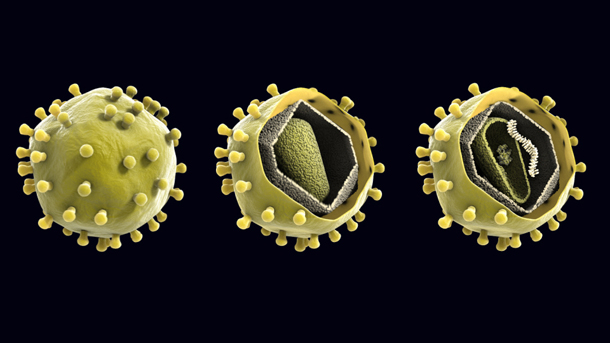 |
| Previous Image | Next Image |
| Description: An RNA virus that fuses to surface receptors located within the host cell's plasma membrane. After binding, the membrane of the retrovirus (the envelope protein) and the membrane of the host cell fuse, transmitting the genetic material of the virus into the host cell. The retroviral genetic material is then replicated in the host cell via the enzyme reverse transcriptase to produce DNA from its RNA genome. The DNA is then incorporated into the host's genome by an integrase enzyme. The virus thereafter replicates as part of the host cell's DNA. Retroviruses are enveloped protein that belong to the viral family Retrovirida. The Yamanaka group utilized retroviral vectors to deliver transgenes that encoded for the four reprogramming factors, Oct-4, SOX2, c-Myc, Klf-4 into the fibroblasts to reprogram them into induced pluripotent stem cells. The transgenes are then integrated into the host’s genome thereby permitting its long term gene expression. If all four transgenes successfully integrate into the fibroblast’s genome, they will they begin to express the transgenes as functional proteins. The four reprogramming factors, Oct-4, SOX2, Klf-4 and c-Myc function as transcription factors meaning that they are capable of binding to the DNA to control the transcription of a unique set of genes. Together Oct-4, Sox2, Klf-4 and c-Myc induce the expression of genes that are not normally expressed in the fibroblast but are expressed in pluripotent stem cells. The four transcription factors continue to drive transcription of their downstream genes leading to the activation of other transcriptional networks inducing a cascade of transcriptional activity. Over the period of two to three weeks, the gene expression profile of the fibroblast changes and begins to express a repertoire of genes that are commonly identified in pluripotent embryonic stem cells. At approximately the same time, the reprogrammed fibroblasts undergo morphological changes. Soon after, the reprogrammed cells begin to grow as a tightly packed cluster of cells known as a colony, which mirrors how undifferentiated embryonic stem cells grow in culture. The emergence of these colonies is the first sign that the fibroblasts have been reprogrammed into induced pluripotent stem cells. From here the iPS colonies are isolated and expanded so that they may be used to further our understanding of human development and the onset of many devastating human diseases. Picture Stats: Views: 946 Filesize: 108.95kB Height: 343 Width: 610 Source: https://biology-forums.com/index.php?action=gallery;sa=view;id=11568 Keywords: Retrovirus |
